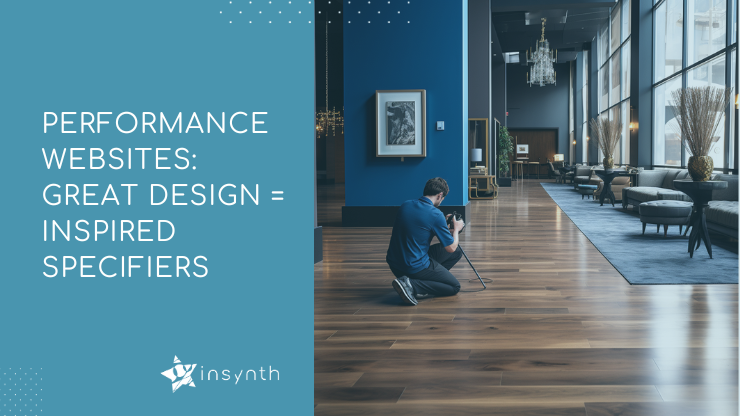3 min read
Performance Websites: Great Design = Inspired Specifiers
![]() Leigh Simpson
:
08-Nov-2023 12:50:00
Leigh Simpson
:
08-Nov-2023 12:50:00

“What I want to see is websites being better curated – more thought about graphically. Because there is nothing worse than having a really good technical resource that is awful to look at.” - Ged Couser, Architect Director, BDP
This is what architects are saying. Why? Because often, manufacturers website are less than inspiring.
Why would you represent your own product in a way that leaves architects underwhelmed? Or worse - "awful to look at".
A visually engaging performance website is crucial for you to effectively showcase you products and engage specifiers, clients, and contractors.
Here is a bit more information behind the psychology of design, a few tips, and some inspiration for your own website, to make sure it inspires specifiers.
1. The psychological advantage of design
Research indicates that 90% of information transmitted to the brain is visual, as our brains are wired to process visual information more quickly and efficiently than text. In fact, visuals are processed at a staggering 60,000 times the speed of text. This means that if you want to captivate and engage your audience, you need to focus on integrating high-quality visual elements into your website.
With great design you can create an immersive and engaging user experience. Complex concepts, product features, and brand messages are conveyed more effectively through visuals, ensuring your audience grasps essential information swiftly and effortlessly.
Additionally, high-quality visuals contribute to the quick conveyance of information, allowing you to make your key messages readily accessible. They also serve as a representation of your brand identity, instilling trust and confidence in your audience.

2. The Anatomy of Good Design
Good visual elements inspire architects by sparking their curiosity and helping them visualize design possibilities. When architects are presented with visually appealing content, it stimulates their creativity and encourages them to think outside the box. They can imagine how different materials, textures, and colors can come together to create stunning architectural designs.
Aesthetic appeal is a crucial aspect of visual elements. Architects are drawn to visually pleasing images that showcase the beauty of a product or design.
Materiality and textures play a significant role in architectural design. Architects are constantly seeking innovative materials that can add depth and character to their projects.
Functionality and performance are essential considerations for architects when selecting products for their designs. Visual elements that demonstrate the practicality and effectiveness of a product can greatly influence an architect's decision-making process.
Contextual understanding is crucial for architects to create designs that integrate seamlessly into their surroundings. Visual elements that provide contextual information, such as images of a product in different environments or architectural renderings, can help architects envision how a product will fit into their designs.
Design flexibility is another aspect that architects value when selecting products. They seek products that can adapt to different design requirements and allow for customization. Visual elements that showcase the versatility and flexibility of a product can inspire architects to explore design possibilities and push boundaries.
3. How to tick all the boxes
Ok, enough theory. Let's get down to the practicals:
- Use high-quality photographs to showcase products from different angles, distances, and settings.
- Demonstrate real-world application with images or videos of products in completed projects.
- Create short, informative videos explaining features, benefits, and installation processes.
- Employ 3D renders and animations for a detailed visual representation of products and components.
- Provide visual guides for installation and maintenance procedures.
- Offer interactive 3D models for a thorough exploration of product design, materials, and components.
- Show before and after comparisons to demonstrate the impact of your product on projects.
- Develop infographics to highlight key features, benefits, and data points.
- Maintain consistent branding and design across all visual elements, including the use of fonts.
- Optimise visual elements for web and mobile devices for quick loading and proper display.
Conclusion
Incorporating these design elements will result in a comprehensive visual experience that captivates your target audience, strengthens your brand, and drives user engagement. By effectively using photographs, videos, 3D renders, and other visual elements, you will create a lasting impact on specifiers and foster a sense of trust and loyalty to your brand.
Remember, success lies in the thoughtful combination of aesthetics, storytelling, and technical information that caters to the needs and preferences of your audience. If you'd like help pulling all this together please reach out to leigh@insynth.co.uk.
ABOUT INSYNTH
At Insynth, we deliver a predictable flow of leads, customers, and specifications for building product brands through our inbound marketing approach, proven to connect with a technically demanding audience.
The latest marketing techniques such as construction inbound marketing, help building product companies to grow sustainability.
As the only HubSpot-certified agency to major in construction marketing. We have a proven formula of bringing a variety of functionalities together including CRM Implementation, Web Design, SEO, and Content Marketing to achieve your ultimate aim: Growing your business and gaining new specifiers and customers.
Book A Free Consultation Today to discover more.

